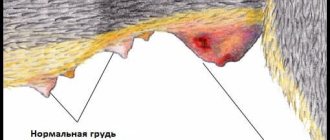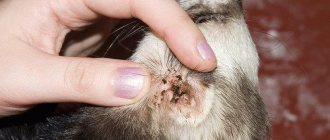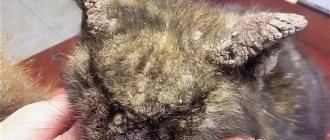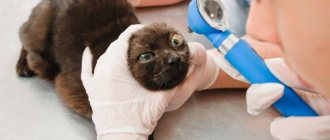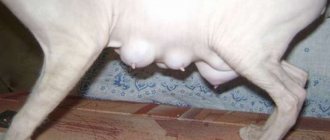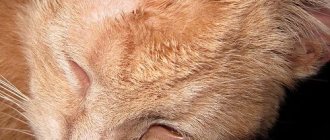Symptoms of mastitis in cats Diagnosis Treatment of mastitis in cats Prevention Mastitis in a cat is an inflammation of the mammary glands. The disease can occur in a chronic or acute form. Usually occurs during lactation (feeding kittens) due to mechanical injury to the glands or infection through skin lesions. It can develop due to early weaning of kittens, after a false pregnancy or estrus. It may also be a consequence of intoxication or postpartum infection. Predisposition to the disease is hereditary.
Lactation mastitis
Lactation mastitis develops in a nursing cat. The mammary glands become so inflamed that they swell to enormous sizes. The cause of this mastitis is stagnation of breast milk, as well as various infections.
If lactation mastitis occurs, you must immediately express milk to prevent the spread of infection. The multiplying bacteria encourage the fermentation process in breast milk.
- As a result, the epithelium is damaged, which interferes with the outflow of fluid.
- This can lead to damage to the lymph nodes and veins.
- Non-lactation mastitis is a rare phenomenon that is not associated with breastfeeding and milk production.
- Its cause is immunodeficiency, as well as injuries to the mammary glands and skin diseases.
- Non-lactation mastitis is easier and is treated faster than lactation mastitis.
How to express milk to a cat
To express milk from a lactating female, it is recommended to use a special breast pump. If the device is not available, it is easy to make it yourself. To do this, take a plastic disposable 5 ml syringe. The piston is removed from it and the top is evenly cut off along with the nose, which is intended for the needle. Next, the cut is melted over fire. Allow the plastic to cool slightly and smooth out the edge with your fingers so that it is smooth and without sharp protrusions. Put the piston in place.
To express milk, the device is applied to the skin so that the nipple is in the center of the cut out circle. When the piston is raised, a vacuum is created in the breast pump and milk flows into the container. It is enough to do this procedure once a day. The entire process of making the device and pumping is clearly shown in the video:
Before using a pumping device, you need to make sure that your cat does not have a blocked milk duct!
Serous and catarrhal
One form of the disease is serous mastitis, which leads to swelling of the glands and an increase in their temperature. The nipples secrete a white-yellow fluid.
During palpation, the animal does not feel pain, which allows for a high-quality examination. The disease is characterized by redness of the skin.
- Catarrhal mastitis affects only the inner lining of the mammary glands.
- The clinical picture is the same as for serous mastitis.
- A large number of white flakes appear in the milk, which clog the ducts of the glands, which leads to stagnation of milk.
- This background is favorable for pathogenic microflora. Milk gives off an unpleasant odor.
Diagnostic methods
What to do if your cat has a swollen nipple? First of all, the animal is examined by a specialist. Next, the cat's blood and the substance discharged from the chest are taken for analysis. Bacteriological examination of mammary gland secretions allows us to identify the causative agent of the disease. Cytological analysis of the fluid shows the degree of development of mastitis or another disease.
Ultrasound is a universal research method for both mastitis and tumors. Using ultrasound, the affected area and the size of the compaction are determined, as well as the presence of contents in the gland ducts.
To find out the nature of the compaction, a biopsy is performed. Cells from lymph nodes located in the affected area are also taken for analysis. It is possible to clarify the presence of metastases in malignant neoplasms using the X-ray method.
Hemorrhagic and gangrenous mastitis
The hemorrhagic form of the disease is a complication of serous and catarrhal mastitis. Characterized by redness of the breast area.
- Spots may appear as this form causes hemorrhages and bleeding.
- The disease is accompanied by pain, fever, and tissue swelling.
- The cat's condition is depressed. This is the most dangerous form of mastitis.
Gangrenous mastitis develops in an advanced stage of necrosis. The skin becomes blue or brown. Bleeding ulcers form if the animal’s immunity is weakened.
Phlegmonous and fibrinous form
The phlegmonous form is a purulent mastitis that affects adipose and connective tissue. The skin condition worsens, the temperature rises, and loss of consciousness may occur. If help is not provided in time, the cat will die.
Fibrinous mastitis is accompanied by blockage of the ducts. Symptoms: Fever, intoxication, apathy, enlarged lymph nodes and mammary glands. When you feel the inflamed areas, you can hear sounds reminiscent of crunching.
Associated symptoms in the presence of pathologies
The onset of a pathological process is indicated not only by the inflammatory process, lumps and discharge. With mastitis, the following symptoms can be observed:
- hot and bright red skin of the areolas;
- animal anxiety;
- soreness when palpated;
- bloody, purulent or cheesy discharge from the nipples;
- change in behavior (apathy, lack of mobility, desire for solitude);
- compulsive licking of the affected area;
- temperature rise to 40 degrees.
The following signs are characteristic of malignant formations:
- clearly defined boundaries;
- hardness and immobility;
- normal skin temperature in the affected area;
- no pain on palpation;
- rapid tumor growth;
- the appearance of ulcers, which may later burst;
- weight loss and loss of appetite;
- the occurrence of metastases.
When a cat is pregnant or breastfeeding, she has a small lump (swelling). A similar situation can be noticed in the case of a false pregnancy. All these phenomena have similar manifestations to tumors, although they are not tumors. But because of this, many owners may already be wondering what to do and how long their pet will live.
Any, even minor, bump in the nipple area should cause concern. Often the pathology is a nodular formation located in the thoracic region. It often affects simultaneously several lobes of the gland, localized in one specific part of the body. Cystic formations may appear.
Adenocarcinoma, being the most common tumor of this organ, has the following manifestations:
- A minor formation that is located under the skin;
- Inflammation of tissue near the tumor;
- Development of ulcers, their bleeding (If they burst);
- Growth of lymph nodes;
- The appearance of pain;
- Fever;
- Development of the necrotic process;
- Significant decrease in appetite.
In the case when a cat has certain seals in the nipple area, the owner needs to immediately show it to the veterinarian to determine their nature. Based on the timeliness of detection of the pathology, as well as its type, not only the treatment depends, but also the possibility of survival of the pet itself.
Purulent mastitis
With purulent mastitis, milk completely disappears. The mammary glands are enlarged, swollen with elevated temperature. The skin is red. Pus and blood are released from the inflamed nipples.
- The areas affected by mastitis are hard and painful.
- After a while, general symptoms appear in the form of elevated body temperature and intoxication.
- The cat is apathetic and seeks solitude.
- In most cases, the disease enters the chronic stage.
The abscess form is a severe type of purulent mastitis, when capsules filled with pus appear inside the gland. If they rupture, the cat dies from blood poisoning.
Daily monitoring of the condition of the milk bed
In most cases, cats, being fairly clean animals, carefully monitor their hygiene. But in some cases, the owner’s help is still required. It is very important to monitor the condition of a nursing cat's milk bags daily.
The occurrence of redness, suppuration or large cracks requires immediate consultation with a veterinarian.
Otherwise, an inflammatory process of the mammary glands may develop. In some cases, a procedure for expressing milk is required. Compresses may be required. If the pathology is advanced, it may be necessary to prescribe a course of antimicrobial drugs.
Causes of the disease
There are many reasons for the development of mastitis.
The main ones are:
- Unremoved milk after kittens are weaned from the cat. Experts recommend picking up babies no earlier than two months of age. It is advisable to express the milk so that stagnation does not form, leading to mastitis;
- Hypothermia of the glands due to prolonged exposure to the street during the cold season, running air conditioning or drafts at home. Cats are very sensitive to drafts and temperature changes;
- All nipples are not involved in the feeding process;
- The birth was performed by caesarean section. After surgery, the cat cannot feed the kittens breast milk, which leads to stagnation;
- Injury to the mammary glands: scratches, baby bites, cracks;
- Immunodeficiency to which cats are susceptible. Against the background of weak immunity, various diseases can develop that complicate mastitis;
- Sterilization with complete removal of the uterus.
Strict hygiene and proper cat care
In the first few days after birth, the pet needs increased attention from the owner. Properly organized care for a cat who has given birth and her offspring will avoid serious complications such as mastitis, and the recovery process will be as easy as possible.
It is necessary to organize care for a woman in labor in such a way as not to harm the cat. There is no need to cross the boundaries of obsession. It is important to observe, but try not to disturb the animal unnecessarily. Strict adherence to hygiene and organization of proper care consists of several main points:
- the place where the cat gave birth to kittens should be located in a dark, secluded place;
- the nest should not be in a draft;
- there should be no noisy devices at the location of the box;
- the bedding should always be kept clean (disposable diapers are best).
If a room in which the air temperature is lower than it should be, place a bottle of warm water in the nest. You can use an electrically heated mat, but you will need to follow safety precautions. Some breeders have infrared lamps in their arsenal that allow them to maintain the required temperature in the room.
Near the nest, it is recommended for the cat to place a bowl of water and food, as well as a cat litter box. This will allow the cat to leave the nest for a short time.
Find out more How to care for a cat after giving birth>>>
Diagnosis and complications
As the disease progresses, symptoms become apparent. In a veterinary clinic, to determine the form and degree of mastitis, they do: a general blood test, collection of biological material, and ultrasound. After which a specific treatment is prescribed.
Mastitis in animals is very rarely accompanied by complications. Especially if you go to a veterinary clinic for timely help.
Types of complications:
- Infection of neighboring organs;
- Damage to the heart or brain;
- The appearance of purulent formations throughout the body—sepsis;
- Painful or toxic shock;
- Development of breast tumors.
Methods for treating mastitis
Treatment of mastitis in cats consists of drug therapy and, in advanced cases, surgery.
- Before going to the clinic, you can provide first aid to your cat: Reduce the animal’s fluid intake and express milk.
- If there are cracks in the nipples, then you can’t express milk, just like you can’t feed babies.
- After the specialist has determined the form and extent of the disease, he prescribes injections to the cat for mastitis, which relieve inflammation with Mastomethrin, Calcium gluconate or Travmatin.
Also, diuretics and drugs to strengthen the immune system are prescribed. Advanced disease is treated with Novocaine, antibiotics and antifungal drugs. The duration of treatment depends on the severity of the disease and ranges from five days to a month. Surgery is prescribed for abscess and severe tissue damage.
As an aid, you can use a cabbage leaf, which is applied to the inflamed areas. Pre-beat the sheet.
- You can make a compress from a decoction of chamomile, oak bark and other antiseptic herbs.
- Sage decoction is used to reduce lactation. Rubbing in special ointments or oils, such as camphor or linseed, will help speed up recovery.
- Treating mastitis in a cat at home is possible only after consulting a veterinarian.
- Since treatment at home can be carried out in the early stages of a mild form of the disease.
During treatment, it is important to dose the cat’s water intake, isolate the kittens from the mother cat, and put on a blanket that will protect them from licking and attempts to feed the cubs.
Prevention
Prevention of mastitis is very important for stylized cats and lactating females, since advanced mastitis in a cat can lead to serious consequences, including the death of the animal.
As preventive measures, veterinarians advise:
- Limit the consumption of fluids and foods that stimulate lactation;
- Treat the nipples of a nursing cat with decoctions of antiseptic herbs;
- Timely vaccinate the cat and carry out deworming;
- Clean the room and clean the cat's bedding as often as possible;
- Inspect the nipples of a nursing cat; if alarming symptoms appear, immediately contact a specialist.
The majority of deaths are caused by attempts at self-medication by the owners of their pets.
